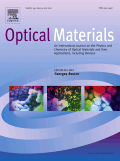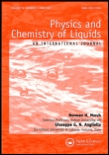
Liquid Crystals Today
metrics 2024
Navigating the Dynamic World of Liquid Crystals
Introduction
Liquid Crystals Today, published by Taylor & Francis Ltd, is an essential platform for researchers and professionals focusing on the fascinating field of liquid crystals. With an ISSN of 1358-314X and an E-ISSN of 1464-5181, this journal covers significant advancements in areas such as Condensed Matter Physics, Inorganic Chemistry, and Materials Chemistry, reflected in its recent classification within the Q3 quartile across these categories. Established in 1991 and with a rich history of disseminating impactful research, the journal provides critical insights and discussions pertinent to the scientific community. Although it does not follow an open-access model, its rigorous peer-review process ensures high-quality publications that contribute to the body of knowledge in liquid crystals. Researchers looking to stay updated in this dynamic field will find Liquid Crystals Today an invaluable resource.
Metrics 2024
 0.28
0.28 0.70
0.70 2.70
2.70 19
19Metrics History
Rank 2024
Scopus
IF (Web Of Science)
JCI (Web Of Science)
Quartile History
Similar Journals

Photonics Letters of Poland
Empowering Researchers through Open AccessPhotonics Letters of Poland is a prominent journal dedicated to the field of photonics, published by the Photonics Society of Poland. With an ISSN of 2080-2242, the journal aims to foster knowledge and innovation within electronic, optical, and magnetic materials. Although it currently holds a Q4 classification in its category and is ranked in the 21st percentile, it serves as an essential platform for researchers and practitioners to share their findings and advancements. The journal covers a range of topics from foundational research to applied science, highlighting advancements in photonics technologies and their applications. Operating from Warsaw University of Technology, the journal promotes open access to knowledge while ensuring rigorous peer review standards. With its coverage spanning from 2009 to 2024, Photonics Letters of Poland represents a vital contribution to ongoing research within the field, making it indispensable for students, professionals, and academics looking to stay attuned to emerging trends and developments in photonics.

OPTICAL MATERIALS
Advancing Knowledge in Optical ScienceOPTICAL MATERIALS is a peer-reviewed journal published by Elsevier, focusing on the intricate field of optical materials within various scientific domains including atomic and molecular physics, electronic engineering, and chemistry. With an impact factor indicative of its relevance, it ranks in the Q2 category across multiple areas such as Electrical and Electronic Engineering, and Inorganic Chemistry, highlighting its critical position in advancing research and innovation. Established in 1992 and continuing its contribution until 2024, this journal serves as a vital resource for researchers and professionals aiming to disseminate significant findings in material sciences, particularly those related to optical properties and applications. While it does not offer open access, the journal remains essential for academia and industry alike, ensuring the continued exchange of valuable knowledge in this rapidly evolving field.

GIANT
Connecting Scholars to Transformative Ideas in Chemistry.GIANT is a pioneering open-access journal published by Elsevier that has rapidly established itself as a cornerstone in the fields of Chemistry, Materials Chemistry, Polymers and Plastics, and Surfaces, Coatings and Films. Since its inception in 2020, GIANT has been committed to disseminating cutting-edge research and facilitating scholarly communication in these dynamic areas. With a remarkable Q1 ranking across multiple categories, the journal reflects an impressive impact factor within the academic community, evidenced by its standing in the top 82nd percentile in several Scopus classifications. Based in the Netherlands at Radarweg 29, Amsterdam, GIANT embraces a global audience through its open-access model, ensuring that groundbreaking discoveries are accessible to researchers, professionals, and students alike. Fostering innovation, the journal strives to shape the future of materials science and chemistry, making significant contributions in an era characterized by rapid scientific advancement.

JOURNAL OF MODERN OPTICS
Unveiling the Science Behind Light and VisionJOURNAL OF MODERN OPTICS, published by Taylor & Francis Ltd, stands as a prominent bi-monthly journal contributing to the fields of Atomic and Molecular Physics and Optics. With an ISSN of 0950-0340 and an E-ISSN of 1362-3044, this journal aims to disseminate high-quality research that pushes the boundaries of optical science and its applications. Since its inception in 1981, and particularly throughout its publications from 1987 to 2024, the journal has consistently published influential studies that are essential for both academic researchers and industry professionals. Ranked in the Q3 quartile for the 2023 category of Atomic and Molecular Physics and Optics, it has a Scopus ranking of #133 out of 224, indicating its steady presence and relevance in the scientific community. Although it does not offer Open Access options, readers can access its rich repository of literature that delves into innovative optical methods, technological advancements, and theoretical frameworks. The JOURNAL OF MODERN OPTICS is an indispensable resource for those seeking to advance their knowledge and research in modern optical science.

OPTICAL REVIEW
Connecting Researchers in the Realm of LightOPTICAL REVIEW is a distinguished journal published by the Optical Society of Japan that serves as a critical platform for researchers, professionals, and students within the diverse fields of atomic and molecular physics and optics. With its ISSN 1340-6000 and E-ISSN 1349-9432, the journal has had a significant impact on the dissemination of knowledge since its inception in 1994, with a planned coverage until 2024. Although it currently holds a Q4 ranking in the 2023 category quartiles and is positioned at rank #152 out of 224 in the Scopus database, its contributions are vital for advancing optical science. This journal provides a venue for innovative research, review articles, and significant developments that drive the optical sciences forward. Although not categorized as Open Access, it remains an important resource for those seeking to deepen their knowledge and engage with leading-edge research in optics. With its base located at the Kudan-Kita Building in the heart of Tokyo, Germany, OPTICAL REVIEW is poised to continue fostering scholarly communication and collaboration on a global scale.

Liquid Crystals and their Application
Navigating the Evolving Landscape of Liquid CrystalsLiquid Crystals and Their Application, published by Ivanovo State University, is a pivotal journal dedicated to the exploration and dissemination of research in the field of liquid crystal science and its diverse applications. With an ISSN of 1991-3966, this journal aims to bridge the gap between fundamental studies and practical implementations, thereby contributing significantly to interdisciplinary fields such as biomaterials and materials science. Although the journal currently holds a Q4 ranking across various categories such as Biomaterials and Materials Chemistry for 2023, it is positioned to enhance its impact through high-quality peer-reviewed articles that reflect advancements in liquid crystal technology. With a geographic focus on the Russian Federation, this journal encapsulates the innovative research environment in the region while catering to a global audience of researchers, professionals, and students interested in the latest breakthroughs. While the journal is not open access, it maintains a commitment to academic integrity and high standards, inviting contributions that will elucidate the evolving landscape of liquid crystals from 2016 through 2024 and beyond.

PHYSICS AND CHEMISTRY OF LIQUIDS
Illuminating the Complexities of Liquid MaterialsPHYSICS AND CHEMISTRY OF LIQUIDS is a distinguished academic journal dedicated to the exploration and advancement of liquid-state scientific research within the fields of physics and chemistry. Published by Taylor & Francis Ltd, this esteemed journal features contributions that delve into various aspects of condensed matter physics, materials chemistry, and characteristics of electronic, optical, and magnetic materials. With an ISSN of 0031-9104 and an E-ISSN of 1029-0451, it has been disseminating valuable knowledge since its inception in 1968. The journal’s commitment to academic rigor is reflected in its current Q3 rankings across multiple categories, including condensed matter physics and physical chemistry. Although not open access, the journal remains a crucial resource for researchers, professionals, and students seeking to stay at the forefront of liquid research advancements. Its publications contribute significantly to the understanding of the interactions and behaviors of liquid materials, making it an indispensable asset in both academic and industrial contexts.

Frontiers of Optoelectronics
Advancing the Future of OptoelectronicsFrontiers of Optoelectronics is a prestigious peer-reviewed journal published by HIGHER EDUCATION PRESS, focusing on the rapidly evolving fields of electrical engineering, optical science, and material science. With its inception in 2012 and an impressive impact factor achieved by being ranked Q1 in both Electrical and Electronic Engineering and Electronic, Optical and Magnetic Materials as of 2023, this journal exemplifies excellence in research dissemination. Operating under an Open Access model since 2022, it ensures timely and widespread accessibility to cutting-edge advancements and innovative applications in optoelectronics, making it an essential resource for researchers, professionals, and students alike. The journal is indexed in Scopus, with notable ranking positions—Rank #143/797 in Electrical and Electronic Engineering and Rank #55/284 in Electronic, Optical and Magnetic Materials—highlighting its significant contribution to the academic community. Based in Beijing, China, the journal fosters a global dialogue around key technological trends, ultimately driving further development in the field.

Liquid Crystals Reviews
Transforming Insights into Liquid Crystal ApplicationsLiquid Crystals Reviews, published by Taylor & Francis Ltd, is an esteemed journal dedicated to the nuanced field of liquid crystal technology and its applications. With an ISSN of 2168-0396 and an E-ISSN of 2168-0418, this journal has established itself as a vital resource for researchers, professionals, and students alike, providing a platform for rigorous peer-reviewed articles and innovative research findings. Impressively, it holds a Q1 ranking in Chemistry, Condensed Matter Physics, and Materials Science as of 2023, underscoring its significance in these disciplines. The journal spans a convergence period from 2013 to 2024, inviting high-quality contributions that lead to foundational advancements in understanding the properties and uses of liquid crystals. While the journal is not open access, its impact on the scientific community is profound, serving as a cornerstone for knowledge dissemination and advancement in liquid crystal research. Located in the United States with its publishing office in England, Liquid Crystals Reviews operates at the crossroads of innovation and academic excellence.

Optica Pura y Aplicada
Illuminating Innovations in Optics and MaterialsOptica Pura y Aplicada, published by the SOC ESPANOLA OPTICA, stands as a vital platform for the dissemination of cutting-edge research in the fields of Atomic and Molecular Physics, Optics, and related engineering disciplines. Established in Spain, this journal aims to foster the advancement of knowledge in optical science and technology by providing a rigorous peer-reviewed publication outlet for scholars, researchers, and practitioners. Despite being categorized in the Q4 quartile across multiple domains, including Engineering and Materials Science, the journal remains committed to contributing meaningful insights and advancements within its scope. With an ISSN of 0030-3917 and an E-ISSN of 2171-8814, the journal effectively reaches a global audience eager to explore innovative applications and theoretical developments in optics and materials science. Researchers and professionals alike will find in Optica Pura y Aplicada a valuable resource for enriching their understanding and practices in an ever-evolving field, fostering collaborations and promoting research growth until its converged conclusion in 2024.